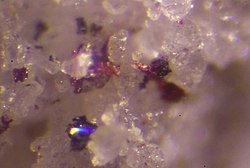| Routhierite | |
|---|---|
 Routhierite cristals (red). | |
| General | |
| Category | Sulfosalt mineral |
| Formula | Tl(Cu,Ag)(Hg,Zn)2(As,Sb)2S6 |
| IMA symbol | Rtr [1] |
| Strunz classification | 2.GA.40 |
| Crystal system | Tetragonal |
| Crystal class | Ditetragonal pyramidal (4mm) H-M symbol: (4mm) |
| Space group | I4mm |
| Unit cell | a = 9.9821(11), c = 11.3122(12) [Å]; Z = 4 |
| Identification | |
| Color | Violet-red |
| Crystal habit | Anhedral grains, xenomorphic grains and veinlets |
| Twinning | Microscopic polysynthetic twin lamellae |
| Cleavage | 2; two perpendicular |
| Mohs scale hardness | 3.5 |
| Luster | Metallic |
| Diaphaneity | Opaque |
| Density | 5.83 |
| Pleochroism | Weak |
| References | [2] [3] [4] |
Routhierite is a rare thallium sulfosalt mineral with formula Tl(Cu,Ag)(Hg,Zn)2(As,Sb)2S6.
It was first described in 1974 for an occurrence in the Jas Roux deposit in the French Alps. [3] It was named after French geologist Pierre Routhier (1916–2008). [5] It is also reported from the Northern Ural Mountains, Russia and the Thunder Bay district of Ontario, Canada. [2]